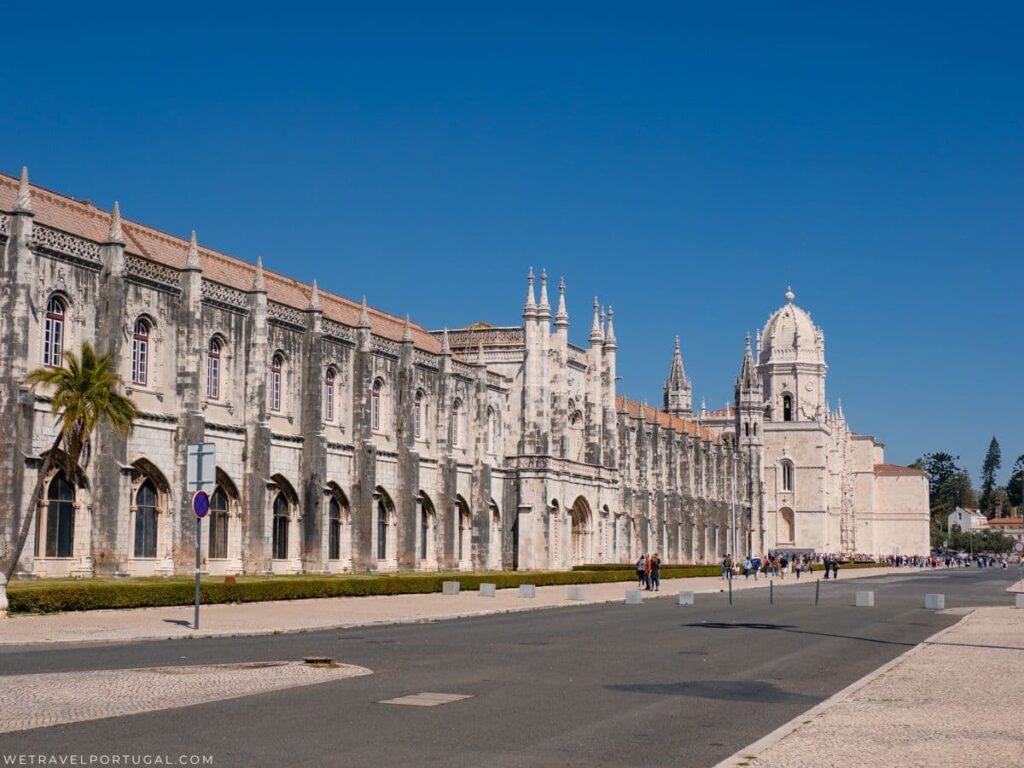Nearly everyone has heard of the ‘Seven Wonders of the World’, a list of man-made wonders that was originally compiled in 100 BC. This list featured seven monuments across the known world of the time – the Mediterranean and Middle Eastern regions. In 2007, Portugal would set about deciding its own version of the Seven Wonders of Portugal. Seven incredible monuments to represent Portuguese heritage and architecture.
The Seven Wonders of Portugal
In 2007, the Portuguese public voted on what they considered to be the Seven Wonders of Portugal. Originally, a staggering 793 monuments were included, but this was then narrowed down to 21 finalists across four different categories.
Then over the following 6 months the Portuguese public would decide which of those 21 finalists would be chosen as one of the Seven Wonders of Portugal. The winners of the Portuguese competition were announced on July 7th, 2007, and it’s reported that over 350,000 people voted in the competition.
Want to find out what the Portuguese public consider to be their wonders and how to visit them all?
What Are The Seven Wonders of Portugal?
- Castle of Guimarães
- Castle of Óbidos
- Batalha Monastery
- Alcobaça Monastery
- Jerónimos Monastery
- National Palace of Pena
- Belém Tower
Castle of Guimarães

First on this list is the Castle of Guimarães, which can be found in the city of the same name. Guimarães itself is steeped in history and is often referred to as the ‘birthplace of Portugal’. The shield shaped castle is an impressive Gothic emblem of Portugal that still stands today.
Guimarães Castle was supposedly the birthplace of the first king of Portugal – Afonso Henriques (Afonso I of Portugal), it’s said that he was born within the castle and baptised in a small chapel on the castle grounds. Today, both the impressive castle and historic chapel can still be visited.
Despite originating in the 10th century, much of the current form of the castle date from expansions and rebuilding in Medieval Era. It’s arguable that the impressive castle could have made the list simply because it was the birthplace of Portugal, not just because it’s a fine example of Early Gothic Portuguese Architecture.
How to Visit the Castle of Guimarães
The Castle of Guimarães is found in the northern city of Guimarães, 365km north of Lisbon, or 55km north of Porto. Currently entry is free due to the castle being refurbished and the parts you can see inside are very limited. The surrounding park, views of the castle, and small chapel are well worth exploring though!
Castle of Óbidos – Castelo de Óbidos

Next on this list is The Castle of Óbidos (Castelo de Óbidos) an incredibly well-preserved castle located in the north of the walled village of Óbidos – a rather wonderful attraction in its own right. The castle’s architecture shows a range of Romanesque, Gothic, Baroque and Manueline influences.
It dates to around 1148, although it’s believed to originally be the site of a Roman fortress, that was then adapted by the Moorish. In 1138, it was conquered by the above-mentioned Afonso Henriques during the Christian Reconquista. Through out the centuries it was continually updated and expanded. During the reign of King D. Manuel I, a luxurious palace was constructed within the castle walls.

Today that palace is an upscale Pousada that you can book overnight stays in! It’s one of the most luxury hotels in the Óbidos area so you’ll have to pay for it (€150 a night in the low season, and as high as €300 in the high season). However, you’ll get to experience the restored rooms and traditional architecture, as well as the historic setting within the castle walls.
How to Visit the Castle of Óbidos
As the Castle of Óbidos is now a hotel and restaurant operated by the national brand Pousada you can visit and enter the castle by booking a room – Pousada Castelo de Óbidos).
However, if you don’t plan on staying as a guest, you can enter the small courtyard for a quick view. The rest of the castle is off limits unless you are a restaurant guest or staying at the hotel. The best views of the castle are from the walls of Óbidos though and I recommend the walk around them to everyone!
Alcobaça Monastery – Monastery of Santa Maria de Alcobaça

To give its full name, the Monastery of Santa Maria de Alcobaça is the monastic complex and abbey in Alcobaça that was founded in the 12th Century by Afonso Henrique. Yep, there’s a very heavy slant to historical places that are tied to the origins of Portugal on the seven wonders of Portugal list! The monastery was established in 1153 when Afonso Henrique donated 44,000 hectares of land in the area to Cistercian Order.
This act was not simply a religious donation, it was a direct attempt to buy favour with Bernard of Clairvaux in Rome. At this time, Portugal was not yet an independent kingdom, and the king’s donation was an attempt to purchase favour at the upper levels of the Catholic church in Rome, as well as promoting the colonisation of the recently recaptured lands.
Through close ties to the royal family, as well as the acumen of the Cistercian order, the monastery would become the richest and most influential in Portugal by 1300. In 1989 the grand monastery was inscribed on the UNESCO World Heritage List due to “Its size, the purity of its architectural style, the beauty of the materials and the care with which it was built’’. It is a masterpiece and regarded as one of the finest examples of Cistercian Gothic architecture.
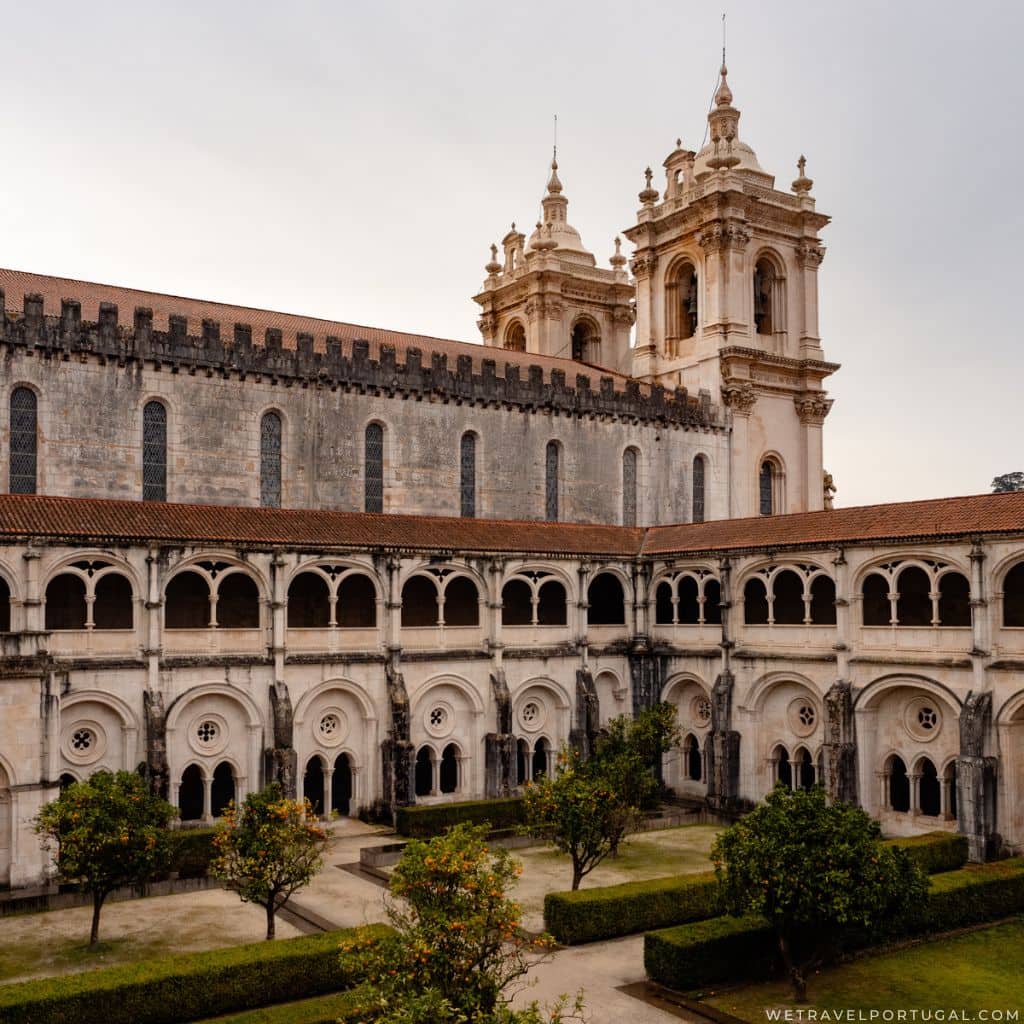
How to Visit the Alcobaça Monastery
Alcobaça is a small but charming town around 100km north of Lisbon. Flixbus and Renex offer daily services from Lisbon to Alcobaça and the journey only takes 1 hour and 40 minutes.
The monastery is central to the town and costs €15.00 to enter, children under 12 get free access. Residents of Portugal also get free access to the full site as it is operated by Museus e Monumentos de Portugal.
Batalha Monastery – Mosteiro da Batalha
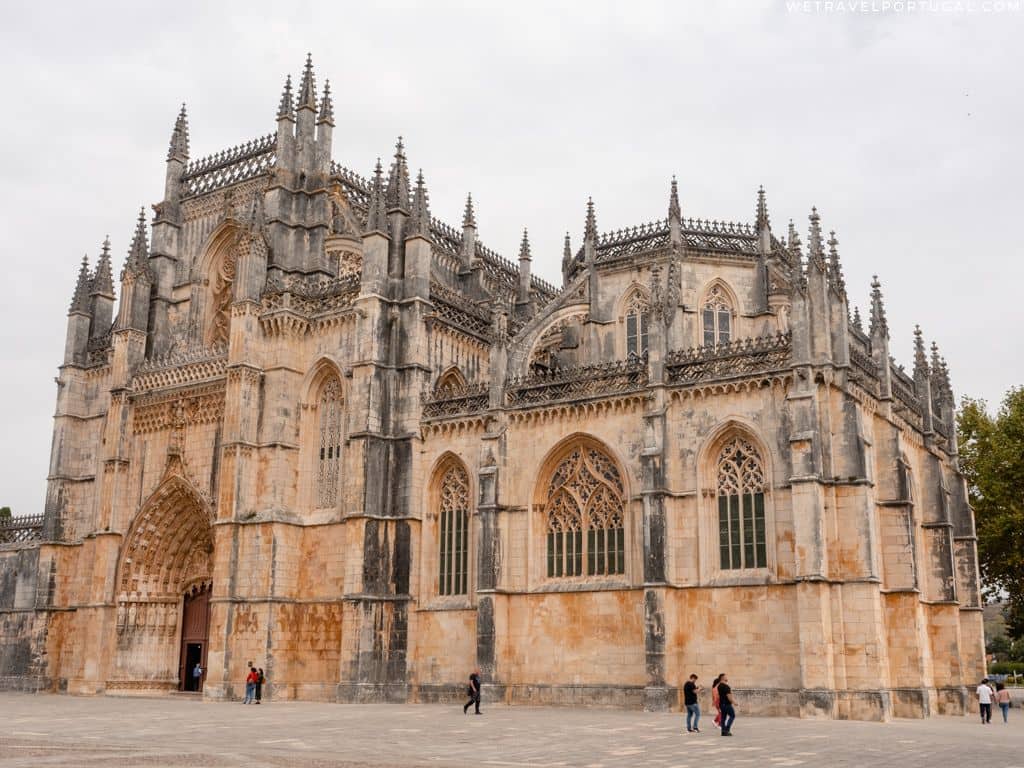
The Mosteiro da Batalha is another building with close ties to the foundation of Portugal. The monasteries creation dates to 1385 and the Battle of Aljubarrota, in which the Portuguese and its allies would defeat the Spanish assuring Portuguese independence.
The legend states that on the eve of the battle, King João prayed to the Virgin Mary. Asking for her assistance and vowing to build a monumental monastery should the Portuguese be victorious. Following his victory at the battle, the king would return to Batalha three years later and begin building the grand monastery. It would become a multi-century project taking over 150 years across multiple phases of construction. This grand monastery was the Portuguese Monarchy’s main building project. Representing the architectural transition from Gothic to Manueline, and although never finished, would influence Portuguese architecture for generations.
For that reason, you’ll find an array of features in not only Gothic style, but also Manueline and some Renaissance touches. Multiple alterations were made to the initial project. Resulting in a vast monastic complex that today includes a church, two cloisters, two royal pantheons – the Founder’s Chapel, and the Unfinished Chapels. It is regarded as one of the finest religious buildings of Portugal and recognised as a place of World Heritage by UNESCO.
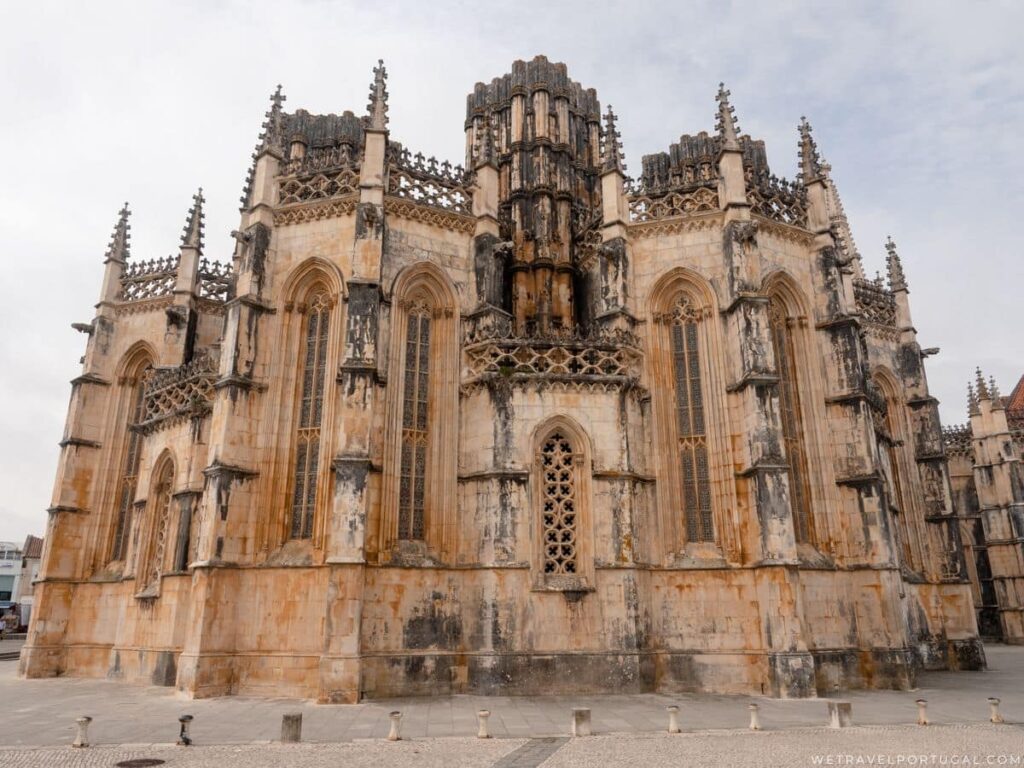
How to Visit Mosteiro da Batalha
Batalha is around 100km north of Lisbon. Once again, Flixbus and Renex offer daily services from Lisbon to Batalha and the journey only takes 1 hour and 50 minutes.
The monastery is central to the town and costs €15.00 to enter, children under 12 get free access. Residents of Portugal also get free access to Mosteiro da Batalha as it is operated by Museus e Monumentos de Portugal.
Jerónimos Monastery
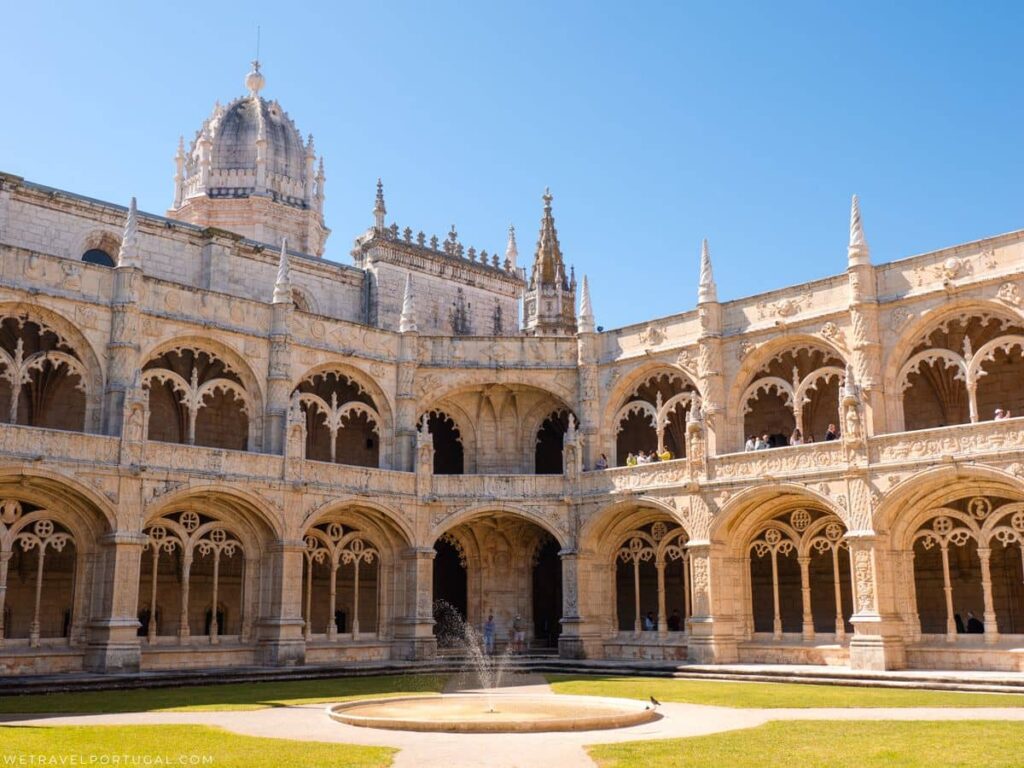
The Jerónimos Monastery or Hieronymites Monastery is the first of two major monuments in the seven wonders list to be found in the Belém district of Lisbon. The Jerónimos Monastery is widely known as one of the best examples of the late Portuguese Gothic Manueline style of architecture in Portugal.
The construction of the monastery began in 1501 and was completed 100 years later. The monumental monastery was able to be constructed through taxes paid on goods from Asia and Africa during the Age of Discoveries. At its time of construction, it involved an ornate architectural style with complex themes that incorporated maritime elements like ropes, shells and coral. This style would later become known as Manueline, and Jerónimos Monastery is often considered the archetype of it.
It was erected in the early 1500s near the launch point of Vasco da Gama’s first journey, and its construction funded by a tax on the profits of the yearly Portuguese India Armadas. In 1880, da Gama’s remains and those of the poet Luís de Camões (who celebrated da Gama’s first voyage in his 1572 epic poem, The Lusiads), were moved to new carved tombs in the nave of the monastery’s church, only a few meters away from the tombs of the kings Manuel I and John III, whom da Gama had served. In 1983, the Jerónimos Monastery was classified as a UNESCO World Heritage Site, along with the nearby Tower of Belém.
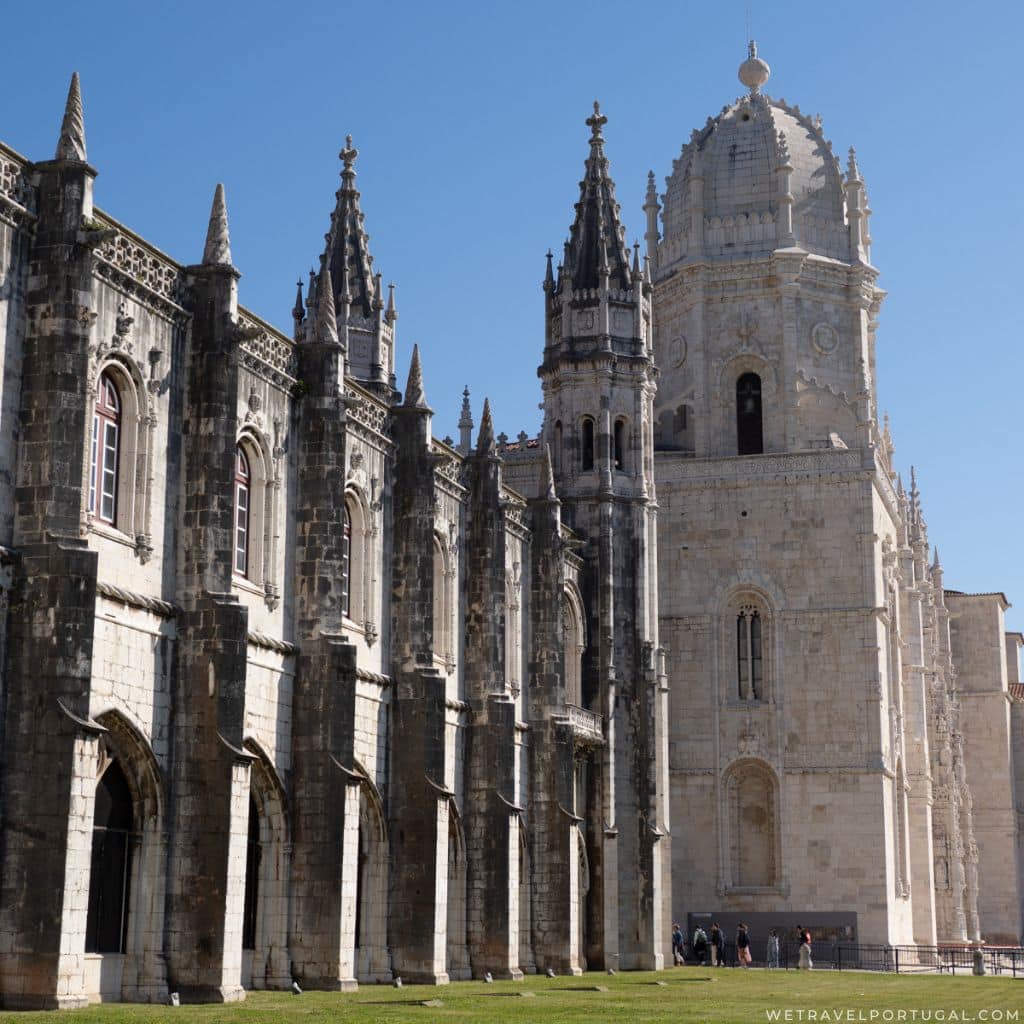
How to Visit Jerónimos Monastery
Jerónimos Monastery is a major monument in Belém and tops most to do lists in Lisbon, because of this careful planning and pre-purchasing tickets is highly advised.
I recommend getting to the site before it opens and getting in queue, with your tickets purchased online. The monastery officially opens at 9.30am, but it’s not unusual to see people start queuing at 9am or earlier. If you don’t pre-purchase a ticket, you’ll also need to go to a separate queue for that as well! Once you’re in front of the monastery, you’ll find two queues, one to go inside the monastery and visit the cloister, and another to visit the church (Igreja de Santa Maria de Belém). I’d recommend going inside the monastery first, then visiting the church.
Tickets for the monastery are €18. Residents of Portugal also get free access to the full site as it is operated by Museus e Monumentos de Portugal.
National Palace of Pena – Palácio Nacional da Pena
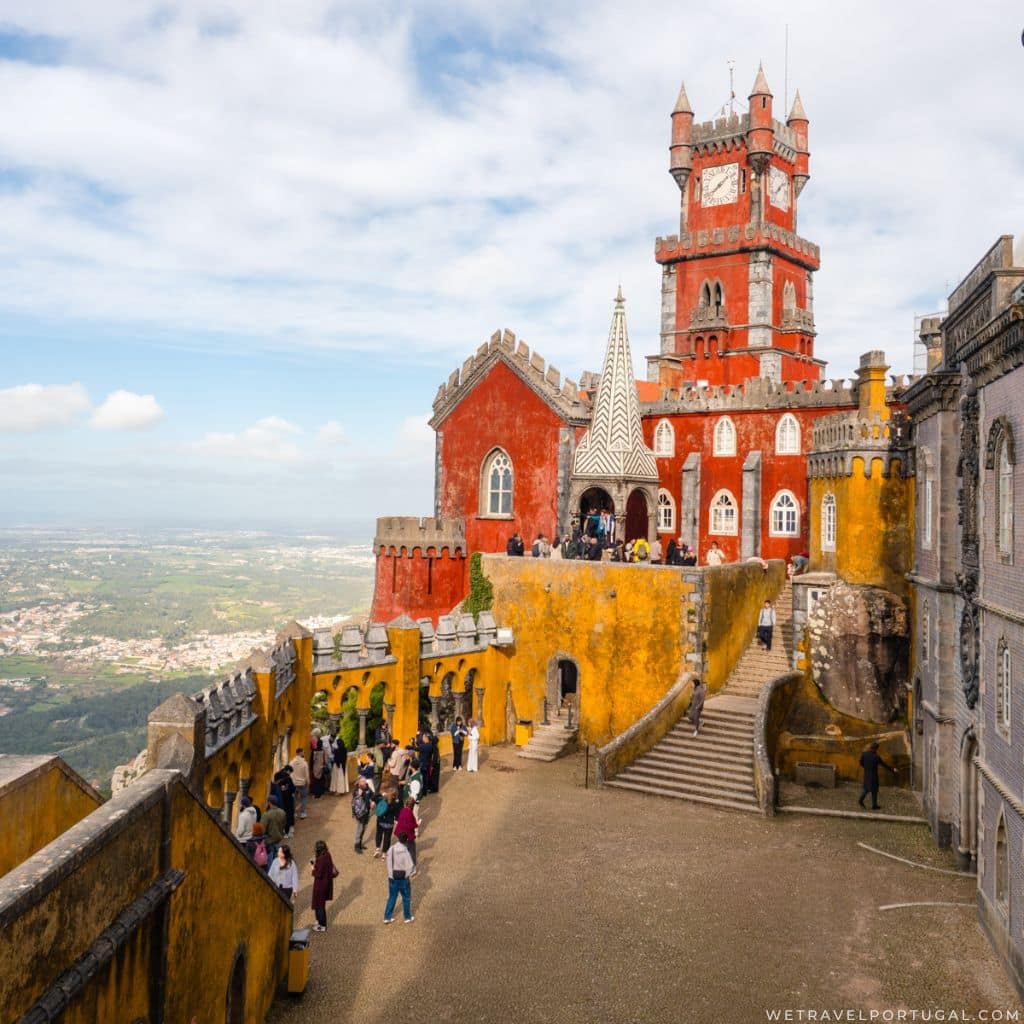
Palácio Nacional da Pena to give its full name in Portuguese is the next wonder of Portugal. If you’re looking for things to do in Portugal, or things to do in Lisbon, then somewhere at the very top of the list is a day trip to Sintra. Often accompanied with photos of the striking red and yellow Pena National Palace. It’s an exotic and fairy tale looking palace, surrounded by dense forested hills dotted with even more palaces, chateaus, and castles.
The palace itself was built on the remains of a former ruined monastery in the mid-19th century and is one of the best examples of 19th-century Romanticism in the world. Throughout its grand walls, archways, windows and halls you’ll find an intentional mixture of architectural styles that incorporate Neo-Gothic, Neo-Manueline, Neo-Islamic and Neo-Renaissance. It’s quite telling that the sixth item on this list is a romanticised call back to many of the other monuments included here!
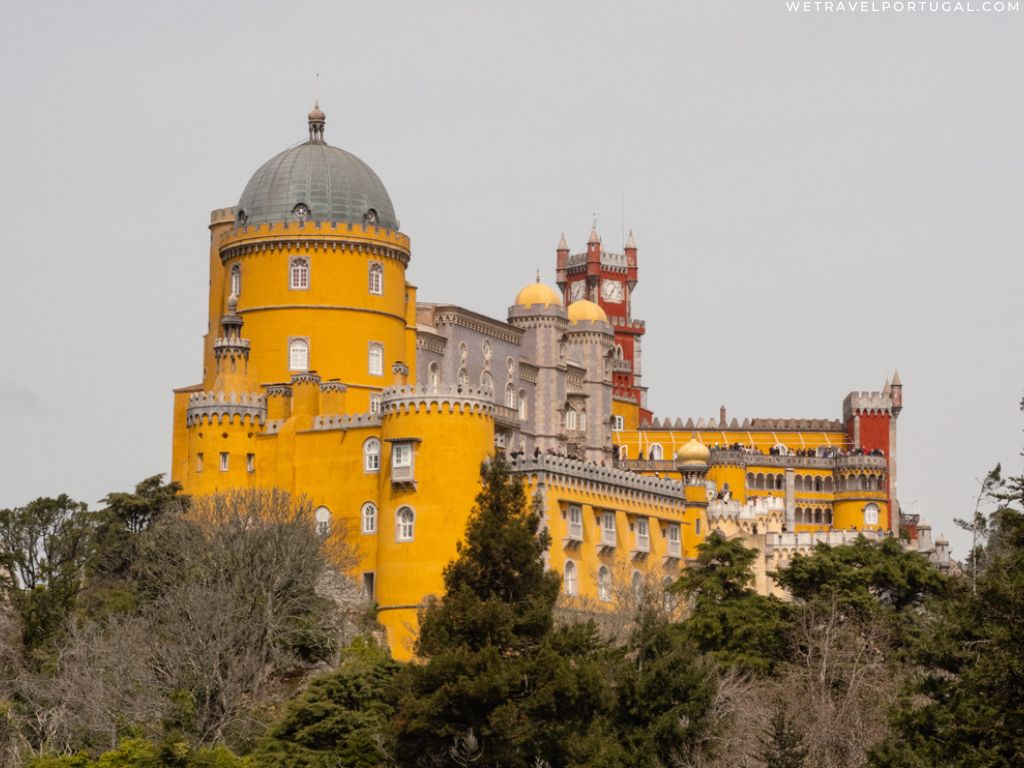
The palace is situated in around 200 hectares gardens and protected forest, offering paths, secret sculptures, and even exotic plants to discover, much of it from the original 19th century plans. Palácio Nacional da Pena is just a small part of what makes the cultural landscape of Sintra, a UNESCO world heritage site.
How to Visit the Palace of Pena
The National Palace of Pena is another monument on this list that requires some careful planning and preparation. It’s the busiest site in Sintra and can get hectic fast if you’re not sure what you’re doing.
The first thing to know, there are two types of ticket for the palace and its grounds. One ticket includes full entry to the palace, terraces and gardens, and a separate ticket that is only for the terraces and gardens. Tickets for the palace and park cost €20.00, tickets for just the park cost €10.00. We strongly recommend buying them online, skipping the lengthy queues for tickets at the entry office itself.
Tickets are timed, and allow entry into the palace for only the time slot previously booked. However, if you miss your time slot you can still view the terraces and the rest of the extensive park and gardens!
Belém Tower – Torre de Belém
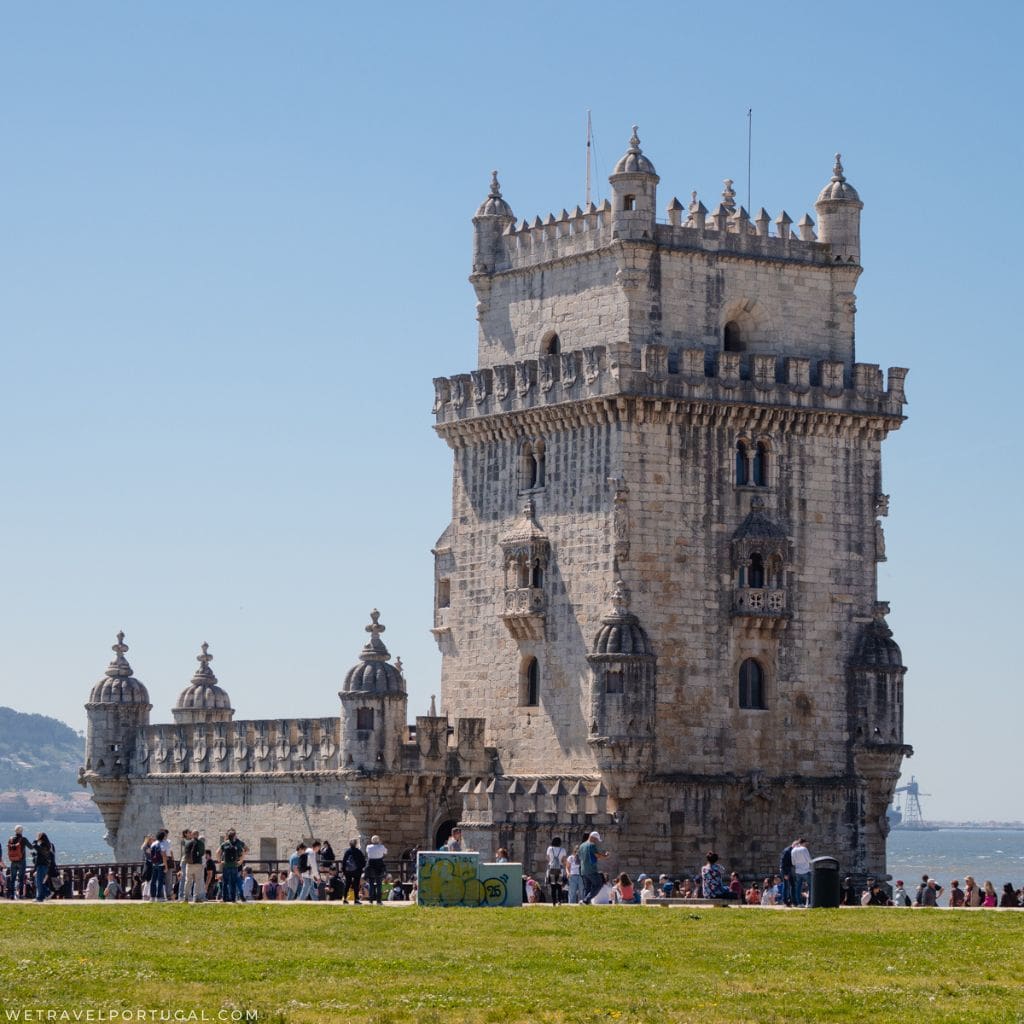
Torre de Belém is the iconic waterfront tower in the Belém district of Lisbon, and often seen together with the Jerónimos Monastery. Officially it’s called the Tower of Saint Vincent, and it is an 30m fortified tower that was designed to defend the valuable ports of Lisbon in the 16th century.
Construction began on the tower in 1514 and it features many elements of the Portuguese Late Gothic Manueline style. As well as the predominantly Manueline style, it also incorporates features of Moorish architecture – now believed to be due to the military architects’ previous work in Morocco. These Muslin features can easily be noticed in the ribbed cupolas of the watchtowers and the arched windows. Today visitors can tour the tower, its five floors, and the roof terrace which offers extensive views of the Tagus River and Lisbon.
How to Visit Torre de Belém
You’ll find Torre de Belém on the waterfront of the Belém district not far from Jerónimos Monastery. Tickets can be bought at the nearby ticket office, and not at the entry point of the tower. Tickets cost €15 and there’s usually a short queue along the promenade for entry to the tower. The tower is one of those places that you don’t need to visit inside, the views are every bit as good from the park and waterside though!
As the site is operated by Museus e Monumentos de Portugal , residents of Portugal can get free tickets.
The Other Finalists
It’s perhaps unfair that the seven winners overly focus on heritage from Lisbon and Central Portugal, in fact there’s only one wonder from outside this area – The Castle of Guimarães in the District of Braga. The rest of the wonders are either in the Lisbon district, or the district of Leiria in Central Portugal.
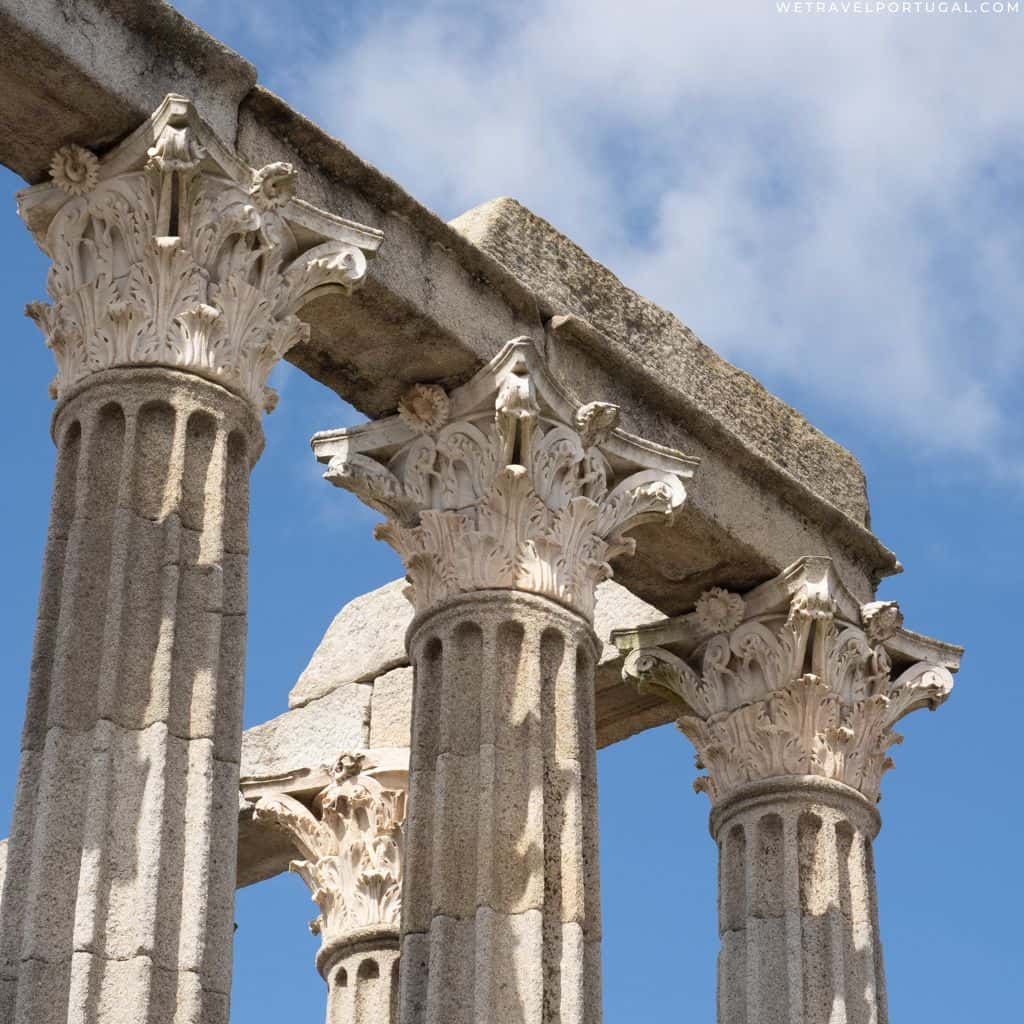
The finalists that did not make the seven are slightly more diverse with four sites from the Alentejo, two sites from the North Region of Portugal, and just one from the Algarve.
Here’s the full list for those curious about the remaining finalists included in the vote for 21.
- Castelo de Almourol, Santarém
- Castelo de Marvão, Alentejo
- Castelo de Monsaraz, Alentejo
- Conímbriga Roman Ruins, Coimbra
- Convento de Cristo, Tomar
- Convento de Mafra, Lisbon
- Fortaleza de Sagres, Sagres, Algarve
- Igreja de São Francisco, Porto
- Paço Ducal de Vila Viçosa, Évora
- Palácio de Mateus, Lisbon
- Palácio Real de Queluz, Lisbon
- Templo Romano de Évora, Évora
- Torre dos Clérigos, Porto
- Universidade de Coimbra, Coimbra
How many of the seven wonders of Portugal have you visited?

